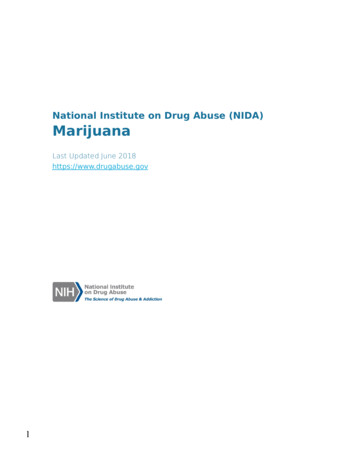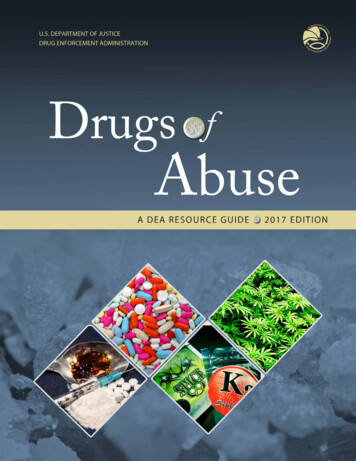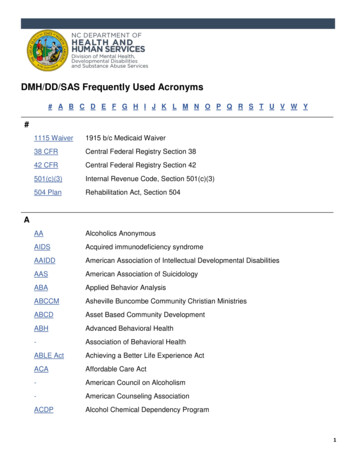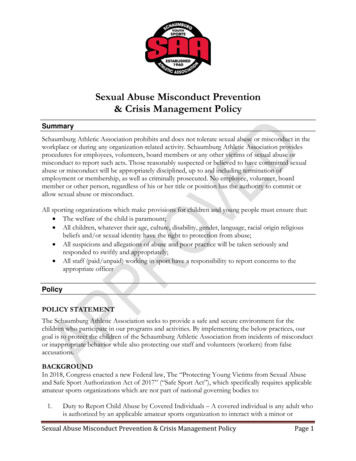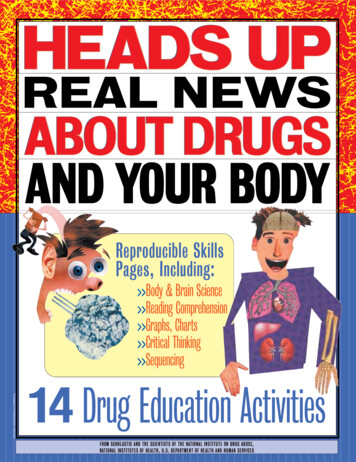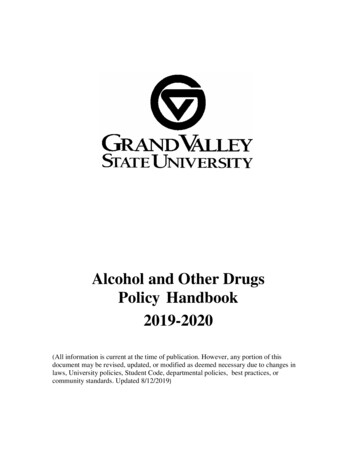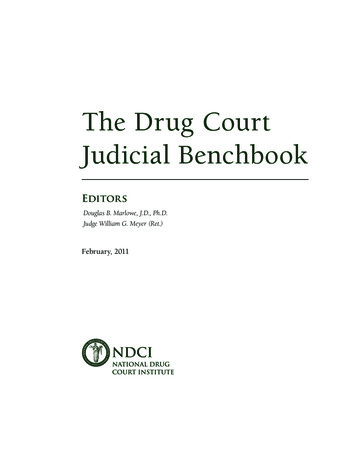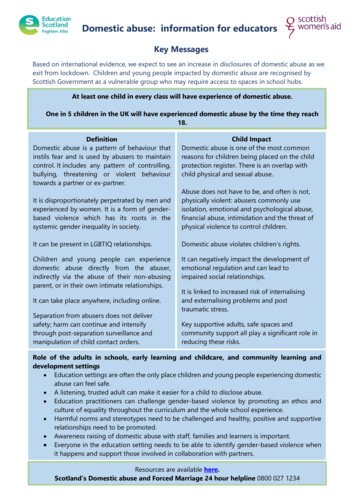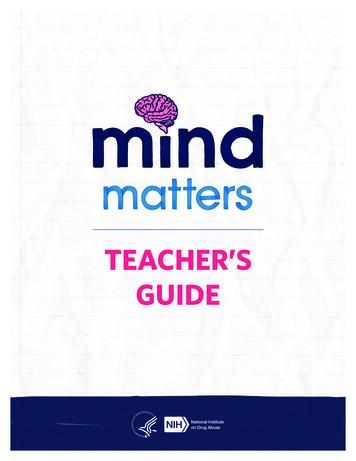
Transcription
TEACHER’SGUIDE
Table of ContentsINTRODUCTION . . . . . . . . . . . . . . . . . . . . . . . . . . . . . . . . . . . . . . . . . . . . . . . . . 3BRAIN ANATOMY . . . . . . . . . . . . . . . . . . . . . . . . . . . . . . . . . . . . . . . . . . . . . . . 4MARIJUANA . . . . . . . . . . . . . . . . . . . . . . . . . . . . . . . . . . . . . . . . . . . . . . . . . . . . 8NICOTINE, TOBACCO, AND VAPING . . . . . . . . . . . . . . . . . . . . . . . . . . . . . . 11INHALANTS . . . . . . . . . . . . . . . . . . . . . . . . . . . . . . . . . . . . . . . . . . . . . . . . . . . . . 15OPIOIDS . . . . . . . . . . . . . . . . . . . . . . . . . . . . . . . . . . . . . . . . . . . . . . . . . . . . . . . . 17METHAMPHETAMINE . . . . . . . . . . . . . . . . . . . . . . . . . . . . . . . . . . . . . . . . . . . 19K2/SPICE AND BATH SALTS . . . . . . . . . . . . . . . . . . . . . . . . . . . . . . . . . . . . . . 22Synthetic Cannabinoids (K2/Spice) . . . . . . . . . . . . . . . . . . . . . . . . . . . . . . . . . . . . . . . . . . . . . 22Synthetic Cathinones (Bath Salts) . . . . . . . . . . . . . . . . . . . . . . . . . . . . . . . . . . . . . . . . . . . . . . . 24COCAINE . . . . . . . . . . . . . . . . . . . . . . . . . . . . . . . . . . . . . . . . . . . . . . . . . . . . . . . 27PRESCRIPTION STIMULANTS . . . . . . . . . . . . . . . . . . . . . . . . . . . . . . . . . . . . 31SUGGESTED CLASSROOM ACTIVITIES . . . . . . . . . . . . . . . . . . . . . . . . . . . . 33
NATIONAL INSTITUTE ON DRUG ABUSE INTRODUCTIONIntroductionThis is the teacher’s guide for the “Mind Matters” series, developed by the National Instituteon Drug Abuse (NIDA), part of the National Institutes of Health. “Mind Matters” includes nineengaging printed materials designed to help students in grades 5 – 8 understand the biologicaleffects of drug misuse on the brain and body, along with identifying how these drug-inducedchanges affect both behaviors and emotions. There is no more important time to address theseissues with adolescents than in the middle school years, when they are forming opinions aboutthe health risks of drugs. These educational materials are also easy to print and use.When used in combination with the printed materials, the background information and lessonplans contained in this guide will help students understand the physical reality of drug use andinspire curiosity about neuroscience. Some activities to reinforce the topics are suggested atthe end of the guide. You can also develop some of your own.MIND MATTERS TEACHER’S GUIDE3
NATIONAL INSTITUTE ON DRUG ABUSE BRAIN ANATOMYBrain AnatomyBACKGROUNDThe human brain is the most complex organ in the body. This three-pound mass of gray and white matter sitsat the center of all human activity. You need it for everything you do — from breathing and thinking to enjoying ameal and creating artwork. The brain regulates your body’s basic functions, enables you to interpret and respondto everything you experience, and shapes your behavior. In short, your brain is you — everything you think and feel,and who you are. The brain has many internal structures, with some seen in Figure 1.MidbrainCerebral cortexThalamusHypothalamusCerebellumAmygdalaBrain stemFIGURE 1 This drawing of a braincut in half shows some of the brain’sinternal structures.HippocampusSpinal cordMIND MATTERS TEACHER’S GUIDE4
NATIONAL INSTITUTE ON DRUG ABUSE BRAIN ANATOMYANATOMY OF A NEURONBACKGROUND (Continued)FIGURE 2DendritesThe brain is often compared to an incredibly complexand intricate computer. Instead of electrical circuitson the silicon chips that control our electronic devices,the brain consists of billions of cells, called neurons(Figure 2), which are organized into circuits andnetworks, working together as a team. Each neuronacts as a switch controlling the flow of information.If a neuron receives enough signals from otherneurons it “fires,” sending its own signal on toother neurons in the circuit.Different brain circuits are responsible forcoordinating and performing specific functions,such as sensing our environment, thinking andreasoning, language abilities, and movement.Networks of neurons send signals back and forthto each other and among different parts of thebrain, the spinal cord, and nerves in the rest ofthe body (the peripheral nervous system).NucleusMyelin sheathCell bodyDirection of impulseAxonAxonterminalsTRANSMITTING NEURONTo transmit a message, a neuron releases a chemicalneurotransmitter via transporter molecules intoTransporterthe gap (or synapse) between it and the next cellmolecule(Figure 3). The neurotransmitter crosses the synapseand attaches to receptors on the receiving neuron,like a key into a lock. This causes changes in thereceiving cell. Other molecules called transportersrecycle neurotransmitters (that is, bring them backinto the neuron that released them), which limitsor shuts off the signal between neurons.Nerve impulseVesicleSynapseNeurotransmittersDendrite ofReceptorreceiving neuronmoleculesRECEIVING NEURONFIGURE 3MIND MATTERS TEACHER’S GUIDE5
NATIONAL INSTITUTE ON DRUG ABUSE BRAIN ANATOMYHOW DO DRUGS AFFECT THE BRAIN?Drugs interfere with the way neurons send, receive, and process signals through these neurotransmitters.Some drugs, such as marijuana and heroin, can activate receptors because their chemical structure mimicsthat of a natural neurotransmitter in the body. This allows the drugs to attach onto and activate the receptors.Although these drugs mimic the brain’s own chemicals, they don’t activate receptors in the same way asa natural neurotransmitter. This can lead to abnormal messages being sent through the network.Other drugs, such as amphetamines or cocaine, can cause neurons to release abnormally large amountsof natural neurotransmitters which prevent the normal recycling of these brain chemicals by interfering withtransporters (Figure 4). This also amplifies or disrupts the normal communication between neurons.TRANSMITTING ne transporterblocked by cocaineFIGURE 4 When cocaine entersthe brain, it blocks the dopaminetransporter from pumping dopamineback into the transmitting neuron,flooding the synapse with dopamine.This takes control of the brain’s rewardsystem, sending out an intense signalto use the drug again.CocaineDopamine receptorsRECEIVING NEURONMIND MATTERS TEACHER’S GUIDE6
NATIONAL INSTITUTE ON DRUG ABUSE BRAIN ANATOMYWHAT PARTS OF THE BRAIN ARE MOST AFFECTED BY DRUG USE?Drugs can alter important brain areas that are necessary for life-sustaining functions and can drive the compulsivedrug use that marks progression to a substance use disorder (SUD) and addiction. Brain areas affected by druguse include: The basal ganglia plays an important role in positive forms of motivation, including the pleasurable effectsof healthy activities like eating, socializing, or playing a game. They are also involved in forming habits androutines. These areas form a key node of what is sometimes called the brain’s “reward circuit” (Figure 5).Drugs over-activate this circuit, producing the euphoria of the drug high. But with repeated exposure, thecircuit adapts to the presence of the drug, diminishing its sensitivity and making it hard to feel pleasurefrom anything besides the drug. The amygdala plays a role in stressful feelings like anxiety, irritability, and unease, which characterizewithdrawal after the drug high fades. This withdrawal motivates the person to seek the drug again. Thiscircuit becomes increasingly sensitive with increased drug use, and over time, a person with an SUDmight use drugs not to get high, but simply to get temporary relief from this discomfort. The prefrontal cortex powers the ability to think, plan, solve problems, make decisions, and exert selfcontrol over impulses. This is also the last part of the brain to mature, making teens most vulnerable to theeffects of drugs. Shifting balance between this circuit and the reward and stress circuits of the basal gangliaand amygdala reduce impulse control and make a person with an SUD seek the drug compulsively.Some drugs — like opioids — also affect other parts of the brain, such as the brain stem, which controls basicfunctions critical to life, including heart rate, breathing, and sleeping . This is why overdoses can cause slowedbreathing and death .REWARD CIRCUITPrefrontalcortexBasalgangliaFIGURE 5 This drawingof a brain cut in half showssome of the brain areasinvolved in the rewardcircuit. The amygdalaresides deep within thebrain; its approximatelocation is l areaMIND MATTERS TEACHER’S GUIDE7
NATIONAL INSTITUTE ON DRUG ABUSE MARIJUANAMarijuanaBACKGROUNDMarijuana is derived from the dried leaves and flowers of the cannabis plant. Delta-9-tetrahydrocannabinol (THC)is the main ingredient in marijuana that makes people high. Marijuana changes brain messages that alter sensoryperception and coordination. This can affect how users see, hear, and feel stimuli and can delay reflexes.HOW DOES MARIJUANA AFFECT THE BRAIN?Marijuana has both short-and long-term effects on the brain.Short-Term Effects:Long-Term Effects:When a person smokes marijuana, THC quicklypasses from the lungs into the bloodstream. Theblood carries the chemical to the brain and otherorgans throughout the body. When a personconsumes marijuana the body absorbs the THCslowly, so the user may not feel the effects for30 – 60 minutes.Marijuana also affects brain development. Whenpeople begin using marijuana as teenagers, whilethe brain is still developing, the drug can impairthinking, memory, and learning functions, and affectshow the brain builds connections between the areasnecessary for these functions. Researchers are stillstudying how long marijuana’s effects last and ifsome changes may be permanent.THC acts on specific brain cell receptors thatordinarily react to natural THC-like chemicals.These natural chemicals play a role in normalbrain development and function.Marijuana over-activates receptors in the partsof the brain that contain the highest number ofthese receptors. Other effects include:The ability to draw definitive conclusions aboutmarijuana’s long-term impact on the human brainis often limited by the fact that in scientific studies,participants often use multiple substances. Also,there is usually limited data about the health andmental functioning of the participants prior tomarijuana use or prior to any particular study. altered senses (for example, seeingbrighter colors) altered sense of time changes in mood impaired body movement difficulty with thinking and problem-solving impaired learning and memory psychosis hallucinations (when taken in high doses) delusions (when taken in high doses)MIND MATTERS TEACHER’S GUIDE8
NATIONAL INSTITUTE ON DRUG ABUSE MARIJUANAWHAT ARE THE OTHER HEALTH EFFECTS OF MARIJUANA?Marijuana use can have a wide range of effects, both physical and mental. Over the years, THC levels in thecannabis plant have grown increasingly higher, and today’s marijuana is more likely to cause side effects —in some cases, sending people to emergency rooms.Physical EffectsBreathing problems – Marijuana smoke irritates the lungs, and people who smoke marijuana frequently canhave the same breathing problems as those who smoke tobacco. These problems include daily cough andphlegm, more frequent lung illness, and a higher risk of lung infections. Whether marijuana smoking is linkedto lung cancer remains an open question.1 While marijuana smoke contains cancer-causing combustionproducts, studies have failed so far to find a definitive link to lung cancer.Lung Illnesses – Scientists are investigating recent serious lung illnesses and deaths related to vaping THC oil,sometimes added to nicotine liquid in vaping devices. In the meantime, public health experts are advising teensto stop using vaping products, especially if bought off the street.Increased heart rate – Marijuana raises heart rate for up to three hours after smoking. This effect may increasethe chance of a heart attack. Older people and those with heart problems may be at higher risk.Problems with child development during and after pregnancy – If a pregnant woman uses marijuana, thedrug may affect certain developing parts of the fetus’s brain. Prenatal marijuana exposure is associated withan increased risk of problems with attention,2 memory, and problem-solving compared to unexposed children.3Research has linked marijuana use during pregnancy to low birth weight and a higher risk of preterm births.4Some research also suggests that moderate amounts of THC are excreted into the breast milk of nursingmothers.5 With regular use, THC can reach amounts in breast milk that could affect the baby’s developingbrain. Until more is known, experts advise pregnant women not to use marijuana.6Intense nausea and vomiting – Regular, long-term marijuana use can lead some people to develop CannabinoidHyperemesis Syndrome. This causes users to experience regular cycles of severe nausea, vomiting, anddehydration, sometimes requiring emergency medical attention.7REFERENCES1. National Academies of Sciences, Engineering, and Medicine. The health effects of cannabis and cannabinoids: Current state of evidence and recommendationsfor research. Washington, DC: The National Academies Press; 2017 https://doi.org/10.17226/246252. Richardson GA, Ryan C, Willford J, et al. Effects of prenatal marijuana exposure on child behavior problems at age 10. Neurotoxicology Teratology. 2000;22(3):325-336.3. Richardson GA., Ryan C, Willford J, et al. Prenatal alcohol and marijuana exposure: Effects on neuropsychological outcomes at 10 years. NeurotoxicologyTeratology. 2002; 24(3):309-320.4. Corsi DJ, Walsh L, Weiss D, et al. Association between self-reported prenatal cannabis use and maternal, perinatal, and neonatal outcomes. JAMA. 2019;322(2):145-152. doi:10.1001/jama.2019.87345. Perez-Reyes M, Wall ME. Presence of delta9-tetrahydrocannabinol in human milk. New England Journal of Medicine. 1982; 307(13), 819-820. doi:10.1056/NEJM198209233071311.6. ACOG Committee Opinion Number 722: Marijuana Use During Pregnancy and Lactation, October 2017 (Reaffirmed 2019)7. Galli JA, Sawaya RA, Friedenberg FK. (2011). Cannabinoid hyperemesis syndrome. Current Drug Abuse Reviews. 2011; 4(4):241-249.MIND MATTERS TEACHER’S GUIDE9
NATIONAL INSTITUTE ON DRUG ABUSE MARIJUANAAddictionResearch suggests that between nine and 30 percent of those who use marijuana will develop a marijuanause disorder — with addiction being the most severe form. Addiction means the brain has changed to thepoint that the teen is no longer able to quit using the drug, despite negative consequences. People who beginusing marijuana before age 18 are 4 to 7 times more likely than adults to develop a marijuana use disorder.Mental EffectsLong-term marijuana use has been linked to mental illness in some people, such as: temporary hallucinations and psychosis temporary paranoia and psychosis worsening symptoms in patients with schizophrenia — a severe mental disorder with symptomssuch as hallucinations, paranoia, and disorganized thinkingMarijuana use has also been linked to other mental health problems, such as depression, anxiety, andsuicidal thoughts among teens. However, study findings have been mixed.HOW USEFUL IS MEDICAL MARIJUANA?Scientists are studying two different ingredients of the marijuana plant for their possible use as medicines — THCand CBD. THC is the chemical that makes you high. It can possibly help decrease pain, inflammation (swelling andredness), and muscle control problems. Two THC-based medicines have been approved for help with nausea fromchemotherapy, and appetite problems with HIV/AIDS patients.CBD, which doesn’t make people high, has shown usefulness in reducing pain and inflammation, controllingepileptic seizures, and possibly even treating mental illness and addictions. A CBD-based medicine was recentlyapproved to treat children with certain severe seizure disorders. However, the whole plant — in smoked or edibleform — has not been approved by the U.S. Government for medical use. Some states allow the sale of marijuanafor certain conditions, but more research is needed to prove its effectiveness. Smoked medicine in particular cancause lung and other health problems, and risks must be weighed against its benefits.MIND MATTERS TEACHER’S GUIDE10
NATIONAL INSTITUTE ON DRUG ABUSE NICOTINE, TOBACCO, AND VAPINGNicotine, Tobacco, and VapingBACKGROUNDTobacco has been used for centuries. The firstdescription of tobacco addiction is contained ina report by Spanish soldiers in the New Worldwho claimed they could not stop smoking.When nicotine was isolated from tobacco leavesin 1828, scientists began studying its effects in thebrain and body. This research eventually showed that,although tobacco contains thousands of chemicals,the main ingredient that produces addiction isnicotine. More recent research has shown that theaddiction produced by nicotine is extremely powerfuland is at least as strong as addictions to other drugssuch as heroin and cocaine.HOW ARE TOBACCO ANDNICOTINE USED?People can smoke, chew, or sniff tobacco. Smokedtobacco products include cigarettes, cigars, bidis,and kreteks. Some people also smoke loose tobaccoin a pipe or hookah (water pipe). Chewed tobaccoproducts include chewing tobacco, snuff, dip, and snus.Snuff can also be sniffed. In recent years, nicotine hasbeen extracted from certain types of tobacco plantsto use as a liquid in electronic cigarettes.HOW DO TOBACCO AND NICOTINEAFFECT THE BRAIN?When a person uses any tobacco, the nicotine isabsorbed into the blood. The nicotine immediatelystimulates the adrenal glands to release the hormoneepinephrine (adrenaline). Epinephrine stimulates thecentral nervous system and increases blood pressure,breathing, and heart rate. Nicotine activates the brain’sreward circuits and increases levels of the chemicalmessenger dopamine, which reinforces rewardingbehavior, as with drugs such as cocaine and heroin.Studies suggest that other chemicals in tobaccosmoke, such as acetaldehyde, may enhance nicotine’seffects on the brain.WHAT ARE OTHER HEALTH EFFECTSOF TOBACCO USE?The nicotine in tobacco is highly addictive, whichcauses the person to continue to smoke. But mostof the severe health effects of smoking tobaccocomes from other chemicals released when litwith flame, burned and smoked. The smoke fromcombustible tobacco products contains more than7,000 chemicals and releases toxins that can leadto lung cancer, chronic bronchitis, and emphysema.It increases the risk of heart disease, which can leadto stroke or heart attack. Smoking has also beenlinked to leukemia and other cancers, cataracts,and pneumonia. All these risks apply to the use ofany smoked product, including hookah tobacco.Smokeless tobacco increases the risk of cancer,especially mouth cancers.Pregnant women who smoke cigarettes run anincreased risk of miscarriage, stillborn or prematureinfants, or infants with low birth weight. Smokingwhile pregnant may also be associated with learningand behavioral problems in exposed children.People who live or work with others who smokeare exposed to secondhand smoke, either comingfrom the burning end of the tobacco product orexhaled by the person who is smoking. This cancause health problems in both adults and children,such as coughing, phlegm, reduced lung function,pneumonia, and bronchitis. Children exposed tosecondhand smoke are at an increased risk of earinfections, severe asthma, lung infections, and deathfrom sudden infant death syndrome. Secondhandsmoke exposure can also lead to lung cancer andheart disease.MIND MATTERS TEACHER’S GUIDE11
NATIONAL INSTITUTE ON DRUG ABUSE NICOTINE, TOBACCO, AND VAPINGWHAT ABOUT ELECTRONIC CIGARETTESAND VAPING DEVICES?Electronic cigarettes — also known as e-cigarettes,e-vaporizers, or electronic nicotine delivery systems —are battery-operated devices that people use to inhalean aerosol, which typically contains nicotine (thoughnot always), flavorings, and other chemicals. They canresemble traditional tobacco cigarettes (cig-a-likes),cigars, or pipes, or even everyday items like pens orUSB memory sticks.Some common nicknames for e-cigarettes are: e-cigs vapesHOW DO E-CIGARETTES WORK?Most e-cigarettes consist of four different components: a cartridge or reservoir, which holds a liquid solution(e-liquid or e-juice) containing varying amounts ofnicotine, flavorings, and other chemicals a heating element (atomizer) a power source (usually a battery) a mouthpiece that the person uses to inhaleIn many e-cigarettes, puffing activates the battery-poweredheating device, which vaporizes the liquid in the cartridge.The person then inhales the resulting aerosol or vapor(called vaping). vape pens mods (customizable, more powerful vaporizers)POPULARITY OF VAPING ON THE RISEA survey collected in 2019 shows alarmingly highrates of e-cigarette use among teens, with ratesdoubling in the previous two years. In 2019, morethan 1 in 4 students in 12th grade reported theyhad vaped in the past month, about 1 in 5 in the10th grade, and 1 in 11 in eighth grade. These selfreported estimates come from the 2019 Monitoringthe Future (MTF) survey, a nationally representativesample of eighth, 10th and 12th graders in schoolsnationwide, funded by a NIDA grant to the Universityof Michigan, Ann Arbor. For more information, ping MarijuanaSome students put marijuana into vaping devices.Reports of marijuana vaping doubled in eighth, 10thand 12th graders between 2017 and 2019, with nearly4% of eighth graders reporting they had vaped THCin the past month in 2019, compared to nearly 14%of 12th graders.8th Graders Who Say TheyVaped Nicotine in the Past Month10%9.0%8%6.1%6%4%3.5%2%0%201720182019MIND MATTERS TEACHER’S GUIDE12
NATIONAL INSTITUTE ON DRUG ABUSE NICOTINE, TOBACCO, AND VAPINGWHY DO TEENS VAPE?The easy availability of these devices, alluring advertisements, appealing technology, and the belief that they’resafer than cigarettes have helped make them popular among teens. Students responding to NIDA’s Monitoringthe Future Survey say they vape because they want to experiment, fit in with friends or because they are “hooked.”They also say they vape because they like certain flavors. This research has led to new rules banning the sale ofmint and fruity vaping pods, starting in the year 2020. The alarming rise in vaping among teens also promptedthe U.S. Government to raise the legal age for purchase of all tobacco and nicotine products to age 21, alsostarting in the year 2020.IS VAPING SAFER THAN CIGARETTE SMOKING?Scientists are still learning about the health effects of vaping, but we know that nicotine in any form is a highlyaddictive drug, and that e-liquids expose the lungs to a variety of chemical mixtures. While people are not inhalingtoxic particles produced by burning tobacco, studies show that e-cigarette vapor contains known carcinogens andtoxic chemicals, as well as potentially toxic metal nanoparticles from the device itself. In addition, the vapor isproduced by heating an oil mixture, and human lungs were not designed to filter an ongoing intake of oil droplets.REPORTS OF DEATHS RELATED TO VAPINGThe Food and Drug Administration has alerted the public to thousands of reports of serious lung illnessesassociated with vaping, including dozens of deaths, with some patients as young as 13. They are workingwith the Centers for Disease Control and Prevention (CDC) to investigate the cause of these illnesses. Manyof the suspect products tested by the states or federal health officials have been identified as vaping productscontaining THC, the main psychotropic ingredient in marijuana. Some of the patients reported a mixture ofTHC and nicotine; and some reported vaping nicotine alone. Vitamin E acetate — used as a filler in the cartridgeliquid — has been linked to the illnesses in many of the samples tested, and scientists continue to try to identifyother potentially dangerous chemicals common to all patients. Until more details are known, FDA officialshave warned people not to use any vaping products bought on the street, and they warn against modifying anyproducts purchased in stores. They are also asking people and health professionals to report any adverse effects.The CDC has posted an information page for consumers, https://www.cdc.gov/tobacco/basic OLE OF TEACHERS AND SCHOOL PERSONNELThe most popular e-cigarette products look like USB memory sticks or thumb drives, oftenunder the brand name JUUL. There are many reports of teens bringing these devices intoclassrooms with teachers not recognizing what they are. In addition, vaping devices do notleave the after-stench of tobacco cigarettes or secondhand smoke, so they can easily beused in school bathrooms with no telltale effects. It is critical that schools develop plansto monitor use of these devices. A recent study shows that many students who hadused e-cigarettes by the time they started ninth grade were more likely than othersto start smoking cigarettes and other smokabletobacco products within the next year.8REFERENCES8. Leventhal AM, Strong DR, Kirkpatrick MG, et al. Association of electronic cigarette use with initiation of combustible tobacco product smoking in earlyadolescence. JAMA. 2015; 314(7):700-707. doi:10.1001/jama.2015.8950MIND MATTERS TEACHER’S GUIDE13
NATIONAL INSTITUTE ON DRUG ABUSE NICOTINE, TOBACCO, AND VAPINGHOW DOES NICOTINE USE LEAD TO ADDICTION?For many who use these tobacco products, long-term brain changes brought on by continued nicotine exposurecan result in addiction. People trying to quit may have withdrawal symptoms, including: irritability increased appetite problems paying attention powerful cravings for tobacco trouble sleeping depressed moodCAN VAPING HELP YOU QUIT SMOKING?Some research suggests e-cigarettes may help people quit smoking cigarettes, while other data suggests thatthey can impede quitting and that they may open the door to traditional cigarette use for people who mightnot otherwise try them. Research so far suggests that vaping devices might be less harmful than combustiblecigarettes when people who regularly smoke switch to them as a complete replacement, however, many peoplewho use e-cigarettes continue to smoke regular cigarettes. The recent Surgeon General’s Report on SmokingCessation, released in early 2020, says there is not enough evidence to conclude that vaping helps peoplestop smoking.HOW CAN PEOPLE GET TREATMENT FOR NICOTINE ADDICTION?Both behavioral treatments and medications can help people quit smoking, but the combination of medicationwith counseling is more effective than either alone.The U.S. Department of Health and Human Services has established a national toll-free quitline, 1-800-QUITNOW, to serve as an access point for anyone seeking information and help in quitting smoking. Or go to https://teen.smokefree.gov/ which also has information about how to stop vaping.MIND MATTERS TEACHER’S GUIDE14
NATIONAL INSTITUTE ON DRUG ABUSE INHALANTSInhalantsBACKGROUNDMost inhalants are common household products that emit mind-altering chemical fumes when sniffed. Thesecommon products include paint thinner, fingernail polish remover, glues, gasoline, cigarette lighter fluid, andnitrous oxide. They also include fluorinated hydrocarbons found in aerosols, such as whipped cream, hair andpaint sprays, and computer cleaners. Teachers should be especially aware that permanent markers, often foundin schools, are also used as inhalants. The ingredient toluene — in most permanent markers — is especially toxic.It is unclear if there are toxic ingredients in various brands of scented water-based markers and scented pencils,because ingredients are not commonly listed. Teachers should not encourage use of these scented productswithout knowing if they are safe to smell.The chemical structures of various inhalants are diverse, making it difficult to generalize about their effects. It isknown, however, that the fumes can change brain chemistry and may permanently damage the brain and centralnervous system.HOW DO INHALANTS AFFECT THE BRAIN?Inhalants enter the bloodstream quickly and circulate throughout the brain and body. They have direct effects onboth the central nervous system (brain and spinal cord) and the peripheral nervous system (nerves throughoutthe body).Using brain imaging techniques, such as magnetic resonance imaging (MRI), researchers have discoveredmarked structural changes in the brains of chronic inhalant users. These changes include a reduced size incertain brain areas, such as the cerebral cortex, cerebellum, and brain stem. These changes may account forsome of the neurological and behavioral symptoms that long-term inhalant users exhibit, including impairedcognitive and motor skills.WHAT ARE THE HEALTH EFFECTS OF INHALANTS?Short-term effects include:Long-term effects of inhalant use may include: slurred or distorted speech liver and kidney damage lack of coordination (control ofbody movement) hearing loss euphoria (feeling high) loss of coordination and limb
Some drugs, such as marijuana and heroin, can activate receptors because their chemical structure mimics that of a natural neurotransmitter in the body. This allows the drugs to attach onto and activate the receptors. Although these drugs mimic the brain’s own chemicals, they don


